Understanding Diversity | Term 1 Unit 1 | Civics | 6th Social Science - Diversity in India | 6th Social Science : Civics : Term 1 Unit 1 : Understanding Diversity
Chapter: 6th Social Science : Civics : Term 1 Unit 1 : Understanding Diversity
Diversity in India
Diversity in India
India is a home to a
civilisation that is 5,000 years old. Different groups of people from different
parts of the world were attracted towards India over the years because of its wealth.
Some came for trade with the local people and others were keen on invading its territory.
So diverse races of people migrated into India by land and sea routes over time.
Thus the Dravidians, Negroids, Aryans, Alpines and Mongoloids became part of the
modern Indian race. Then, the people who migrated to India also moved to other parts
of the country. This movement and migration of people is the reason for India’s
rich diversity.

We will now study the
diversity in India under the following broad headings: land forms and lifestyles
diversity, social diversity, religious diversity, linguistic diversity and cultural
diversity.
1. Land Forms and Lifestyle Diversity
A continent is a very large area of land with various physical features such as mountains, plateaus, plains, rivers and seas and various types of weather patterns. India has all of them. India is known as a sub-continent. These features have an underlying influence upon the people who live in different landforms of the country.
Physical and climatic
features determine the economic activities of a region. People living in the plains
thrive on agriculture, while people in the coastal areas take to fishing for their
livelihood. In mountainous regions, rearing of animals is undertaken. Hilly landscapes
are supported by favourable climatic conditions for the cultivation of coffee
and tea.
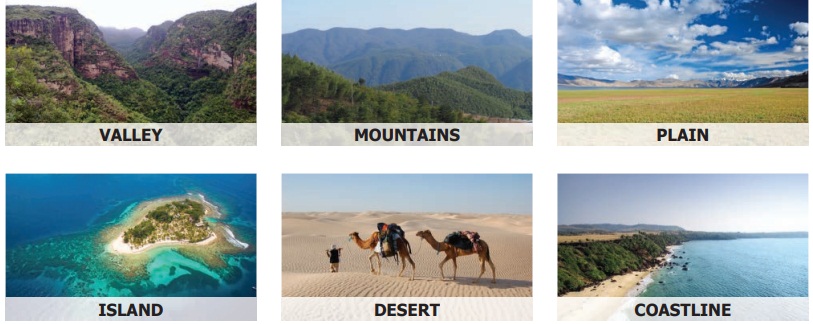
Diversity in landforms
also impacts the flora and fauna of a region. The plant and animal wealth of a place
depends upon the natural habitat and the climate that prevails in that region. Food,
clothing, occupation and livelihood of the people is closely connected with the
region’s natural surroundings and climate.
2. Social Diversity
Interdependence and Co-existence
A community is a place
where people live together with a common interest or heritage. Our community is
made up of peasants, labourers, artisans, parents, teachers, students and many others.
For a comfortable livelihood, communities depend on each other.
• Mawsynram
located in Megalaya, is the land of
highest rainfall.
• Jaisalmer
located in Rajasthan, is the land
of lowest rainfall.
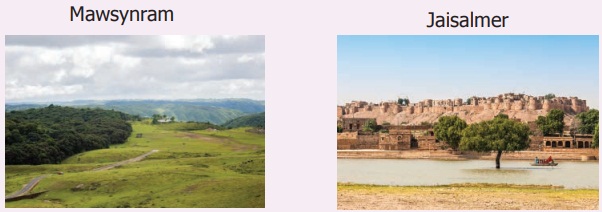
Family and Society
Families constitute
the fundamental unit of a society. There are two types of families: joint families
and nuclear families. Families live in a harmonious neighbourhood. Hundreds of neighbourhoods
collectively form a village and thousands of them group together in a city. The
needs of people and the interdependence of communities for amenities such as water,
food, electricity, education, housing and so on bring us together to live in harmony.
Though we are diverse in our cultural practices, we are united and interdependent
socially.
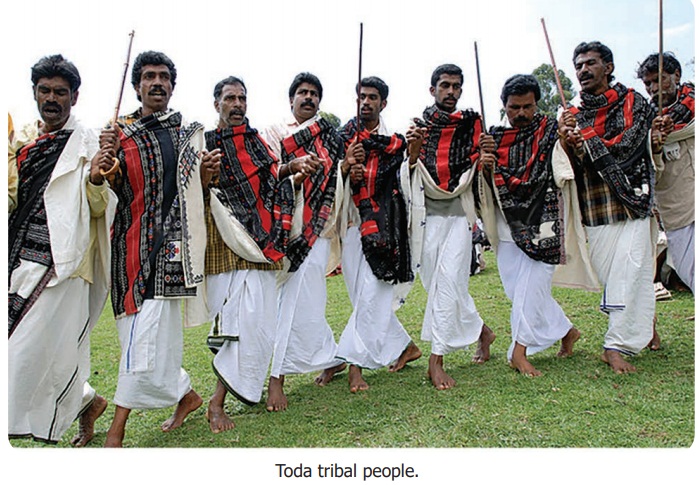
3. Religious Diversity
Our Constitution declares India
to be a secular nation in which all religions are treated equally. The freedom of
religion is our fundamental right. India is the birthplace of many religions and
has become the home of many others. Hinduism, Islam, Christianity, Sikhism, Buddhism,
Jainism and Zoroastrianism flourish in India.
India is a land of festivals, where people from different religions engage in many colourful celebrations in different parts of the country and co-exist harmoniously. The wide variety of festivals celebrated in India is a true manifestation of its rich culture and traditions. Festivals like Pongal, Deepavali, Holi, Vijayadhasami, AyudhaPuja, Navaratri, Durga Puja, Dussehra, Ganesh Chaturthi, Bihu, Kumbamela, Onam, Miladi Nabi, Ramzan, Christmas, Buddha Poornima, Mahavir Jayanthi, Guru Nanak Jayanthi and Rakshabandhan are some of the festivals that denote the cultural diversity of India.
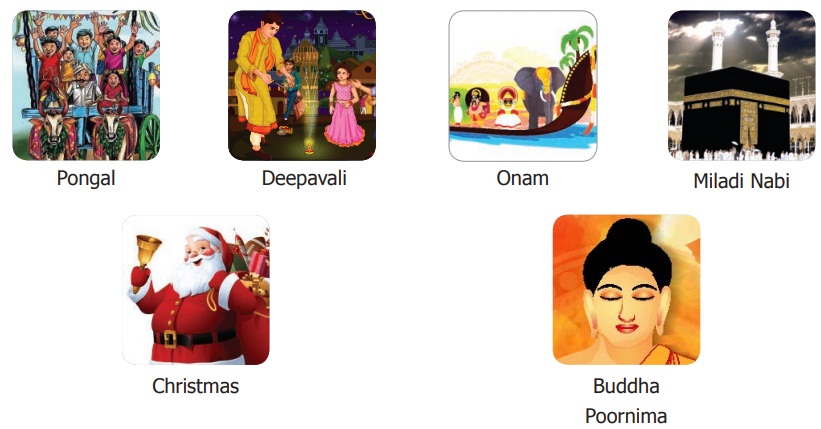
4. Linguistic
Diversity
According to census
of India 2001, India has 122 major languages and 1599 other languages. Four
major Indian language
families are Indo-Aryan,
Dravidian, Austroasiatic and Sino Tibetian. Tamil is the oldest
Dravidian language.Historically, the Portuguese, the Dutch, the British, the
Danish and the French came to India for
trade and their
occupation of India or some parts of it has left behind
a certain impact
upon the culture
and language of the people. The Constitution of
India recognises twenty-two languages as official
languages. The Government of India has declared Tamil as the first
classical language in 2004. Apart from Tamil, five other Indian languages have
been declared as the classical
languages, by the Goverment of India.
Because the British
ruled over the entire country for
over three hundred years before independence in 1947, the English language
gained prominence in India. In due course, English has emerged as an important
language and a medium of instruction in schools and colleges. It is widely used
in official communication and daily life.
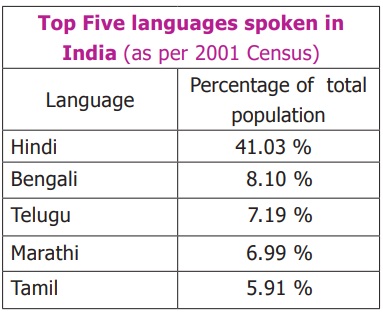
5. Cultural Diversity
The term ‘culture’ refers
to customs and practices of people, their language, their dress code, cuisine, religion,
social habits, music, art and architecture.
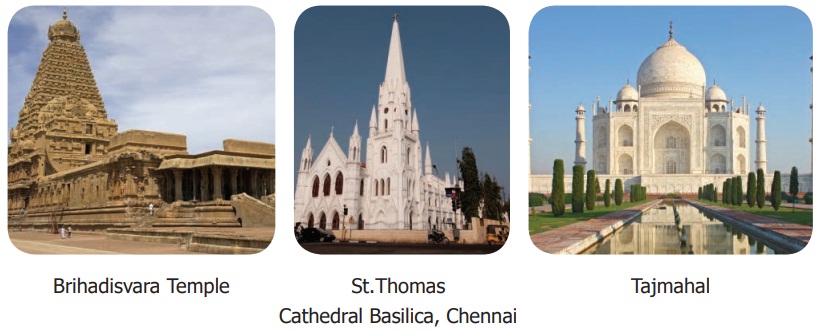
The culture of a group of people
is reflected in their social behaviour and interactions. The group identity fostered
by social patterns is unique to a group.

Art and architecture
are an integral part of every community. It develops as a part of culture and tradition
of a community. Each of the 29 states and 7 Union territories of India has rich
traditions and unique ways of artistic expression.
About 60 percent ofthe total epigraphical inscriptions found by the Archaeological Survey of India (ASI) are from Tamil Nadu, and most of these are in the Tamil script.
Popular Dances of India
In ancient times, dance was considered
as a way to celebrate, worship and also as a gesture of thanks giving and joy. Dances
of India reflect its cultural richness.
Music and dance go hand
in hand. There are several styles of music practiced in India. The Hindustani music,
Karnatic music, Classical Tamil Music, Folk Music, Lavani, Ghazl are some of them.
There are songs from various languages composed by blending these different forms
of music.
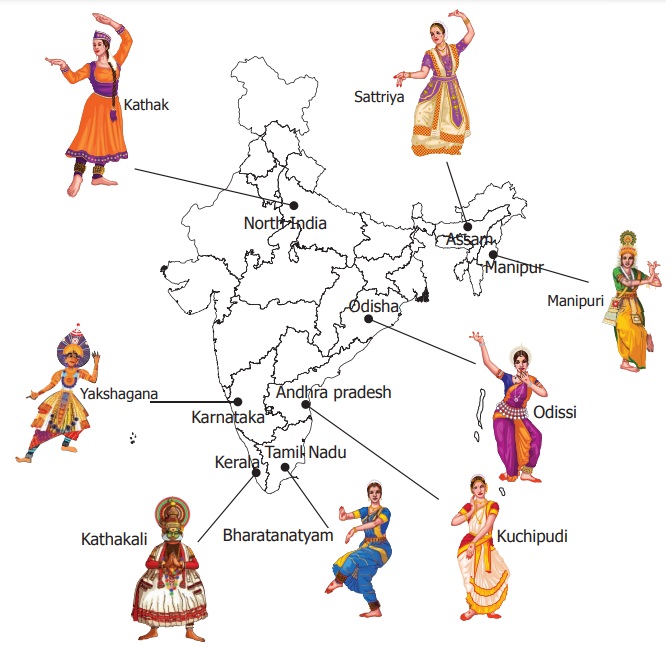
Folk dances of India
State : Popular dance
Tamil Nadu : Karagattam, Oyillattam, Kummi, Therukoothu, Bommalattam, Puliattam, Kolattam, Thappattam
Kerala : Theyyam and Mohiniattam
Punjab : Bhangra
Jammu and Kashmir : Dumhal
Gujarat : Garba and Dandia
Rajasthan : Kalbelia and Ghoomer
Uttar Pradesh : Raaslila and Chholiya
Assam : Bihu
Activity:
You have read about the diversity that exists in our country. Compare and contrast two states in this table.

Related Topics